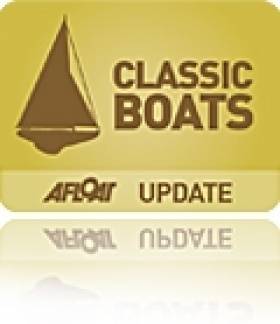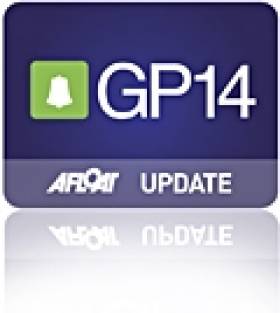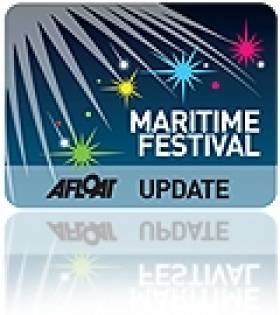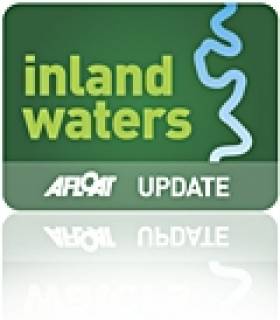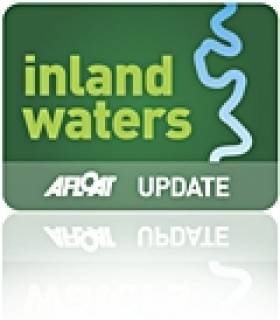Displaying items by tag: Lough Erne
Flooding Remains 'Severe' As Shannon Levels Peak
#Flooding - Flooding in the Shannon catchment is still "severe" according to the National Emergency Coordination Group,
As RTÉ News reports, waters have risen by 2.5cm in the Athlone area, where the Shannon breached its banks before the weekend.
And levels expected to peak on the Lower Shannon later today (Monday 14 December) between Lough Derg and Limerick, which experienced serious flooding in parts of the city not normally affected.
However, as rain persists over coming days, counties in the South and South West remain at risk, as heavy rainfalls "could cause flooding in areas have had no flooding so far".
Meanwhile, at the other end of the waterway, Lough Erne burst its banks in the Enniskillen area at the weekend – rendering a number of roads impassable, as the News Letter reports.
Lottery Funding For Lough Erne A Boost To Wildlife & Traditional Crafts
#LoughErne - Traditional boatbuilding on Lough Erne is set for a revival thanks to a £3 million lottery grant that will also support wildlife conservation on the Co Fermanagh waterway.
As the Belfast Telegraph reports, the £2.9 million Heritage Lottery Fund grant to the Lough Erne Landscape Partnership will be used to conserve heritage buildings in disrepair, preserve and improve wildlife habitats and support the management of some 500sqkm of the county's lakelands.
The reintroduction of traditional crafts is also a goal of the new funding, with the hopes of attracting more tourism to a region already popular with anglers.
In other marine wildlife news, Belfast Live reports that as many as 29 whales, dolphins and porpoises have washed up on Northern Ireland's beaches in the last four years.
The most prominent of these is the 43-foot fin whale washed up on Portstewart Strand over a month ago.
Testing The Latest Westwood Cruiser On Lough Erne
#Cruising - Westwood's latest A405 cruiser was recently put through her paces by Motorboat & Yachting on a recent two-day visit to Lough Erne.
It's been all change for the cruising marque in recent times, keen to shake off its "somewhat stuffy image" since the yard moved to Enniskillen in 2013.
And Jack Haines' video feature on the company's flagship makes those efforts abundantly clear – taking in the idyllic surrounds of Lough Erne between Carrybridge and Enniskillen along the way.
Enniskillen RNLI Needs New Volunteer Crew Members
#RNLI - Enniskillen RNLI is looking for new volunteer crew members to join its search and rescue service on both Upper and Lower Lough Erne in Co Fermanagh.
The lifeboat station currently has 40 volunteers to cover its inshore service on the Lower Lough at Killadeas and the Upper Lough at Carrybridge but is now calling on new volunteers to come forward and find out how they can get involved and help the station to continue to save lives on inland waterways.
And to that end, the station will be hosting an open evening at the new lifeboat station at Carrybridge next Thursday 29 October for all interested candidates to learn more.
Enniskillen RNLI was established in May 2001 and became the charity’s first inland lifeboat station. Today, a great team spirit between Enniskillen’s management, crew and committee members creates an efficient and professional service on the Lough Erne waterway, which works closely with other emergency services to keep water users safe.
Last year, Enniskillen RNLI launched 59 times and brought 57 people to safety.
Now, Jimmy Dundas, Enniskillen RNLI lifeboat operations manager on Lower Lough Erne, is calling on any volunteers who may be interested to come along to the station on Thursday evening and find out more.
"We are looking for anyone aged 17 years and over who is willing to offer some of their free time to join what I believe to be, one of the most exhilarating and rewarding voluntary services that is out there," he says.
"Every volunteer receives first class training from the RNLI and learns new skills which can benefit them in many walks of life. Lifeboat crew members need to have a reasonable level of fitness, have good eyesight and not be colour blind.
"Anyone who would like to volunteer but feels they would not meet the requirements for lifeboat crew should in no way be put off, as shore crew also play an essential role in the launch and recovery of the lifeboat when it goes on service."
Anyone who feels they have the time and commitment to volunteer for the charity, which is on call 24 hours a day and 365 days a year, is asked to email Jimmy at [email protected].
Alternatively, prospective volunteers can come along to the station’s open evening from 7pm on Thursday 29 October at Carrybridge lifeboat station.
Wooden Boat Building In Fermanagh: Keeping The History Alive
#HistoricBoats - The storied tradition of wooden boat building in Fermanagh is the subject of a new exhibition at Enniskillen Library from next Monday 29 June to Saturday 4 July.
Photos, anecdotes and artefacts of the era of clinker-built boats and cots before the advent of fibreglass will be on display at the library each day between 10am and 4pm.
And organisers with Lough Erne Heritage are also looking to gather information from local people, many of whom still have valuable old-school boatbuilding knowledge, that could tell us even more about those bygone days.
Stories, photographs, cine film and images of original boats and related artefacts such as hand tools and early outboard engines - if you have them, bring them along for recording in the collection.
GP14 Ulsters Won By Greystones Pairing McCarthy & Bracken
#gp14 – Always be apprehensive of a GP14 venue described as picturesque... Lough Erne was described as the most picturesque venue one would ever sail and it definitely delivered on that promise. I got to see every nook and cranny of the beautiful venue as we tried to navigate our way around the very trying race course. We arrived Saturday morning with the sun splitting the slipway and the breath-taking views were teeing up a very exciting event in Rory McIlroy's second favourite venue for golf. A great turn out of boats meant a large fleet would make any defending champ (in this case, Alan Blay) nervous at the prospect of holding onto a title. We rigged and launched eager to get around the corner to see the sailing venue for the racing.
A chilly breeze was an early warning sign to anyone who thought this was going to be another sailing event. The Race Officer got the racing off to a quick start and it was clear from the outset that the training Shane MacCarthy and Damian Bracken had put in over the winter was paying dividends and provided them with the extra boatlength required when situations were tight around what was set to be the most tricky racing in the GP's this year.
Lough Erne was a venue where consistency and patience were currency, and no amount of money in the bank would have bought you a race without them. Keith Louden (our lake specialist) was also on form and determined to topple the Macarthy winning streak. Alan Blay, the defending champion, was fired up and ready, staying for the weekend with local tactical genius JP McCaldin to increase his chances of a successful defence. The leader in every race came from the left hand side, crossing the fleet and using the right hand side to approach the top mark. The wind shifted ferociously and the 'bold child' that was Lough Erne laughed as the rest of the fleet sailed in circles trying to deal with the shifting conditions. Tim Corcoran had left himself a lot of work after being over the line in the first race. Over the weekend the naughty GP fleet were to try the patience of the race officer on more than one occasion with multiple restarts because they could not stay behind the line.
Day two launching was similar to day one with gorgeous sunshine guiding our way - however everyone had gritted teeth this time and for good reason. The difficult shifty conditions were to continue and stringing a couple of consistent results together for anyone was rare. Everyone had glimpses of the front of the fleet but hanging onto a lead was virtually impossible. The positions throughout the races were yo-yoing to say the very least except those of Shane and Keith who had set themselves up for a deciding match race in the natural amphitheatre that was Lough Erne. The rest of the fleet could only marvel as two gladiators of Irish GP's wrestled their way through the pack to try and win the title of Ulster champion. The title swapped and changed between the two several times contending with bonkers shifts that literally tacked boats uncontrollably at times. Keith had the lead at the top mark and Shane kept him in his sights throughout the race. Pile ups at three of the marks meant getting around the race course unscathed was a skill in itself, (Not something yours truly managed to do).
A nail biting last broad reach decided the championship and Shane was a well deserved champion, the wind had shifted to favour the chasing pack and filled in from behind, Shane was to leeward and in front of that same pack and chose to use his last ace card to hold the inside lane on Keith at the leeward mark and clinch the title, the boat length which himself and Damian had worked so hard to gain over the winter had been the small inch required to win. The rest of the fleet had to watch and enjoy the spectacle going on around them as they tried to make sufficient sense of the conditions to finish the race.
Special mention must go to the youth sailors in the bronze fleet who showed some of the gold and silver fleet how it's done - Gareth and Richard Gallagher and Peter Boyle sailing with dad Stephen put in a great performance over the weekend. It was also fantastic to see the return of Richard Street - Richard, we've missed you. And thanks again to the event organisers and members at Lough Erne Yacht Club for providing a warm welcome and great racing.
Lough Erne Food Festival This Weekend
#MaritimeFestivals - The inaugural Festival Lough Erne is taking place in the island town of Enniskillen, Co Fermanagh this weekend – a celebration of food and the waterways with fun for all ages.
In the tented village there will be opportunities to meet local food producers and sample the very best of the area's produce, see guest chefs at work and pick up some informative cookery tips and recipes, all whilst tickling the taste buds.
Find out more about the festival's happenings today (Saturday 20 June) and tomorrow at the Fermanagh Lakelands website HERE.
Lough Erne Resort Land Dispute To Be Settled
#WaterfrontProperty - A land dispute relating to the Lough Erne Resort golf course is expected to be resolved next month.
Last October reports confirmed the purchase of the five-star lakeside resort by American billionaire businessman Tony Saliba.
The deal came after much speculation that the Chicago-based 'market wizard' would snap up the site of the 2017 Irish Open.
Neither he nor any holding companies connected to him are involved in the proceedings issued against the former owners of the resort by a Roy Cathcart over a piece of land at the waterfront location, which the News Letter says have resulted in a confidential settlement.
And the High Court has heard that the legal action over the exclusive waterfront property – which hosted the G8 Summit in 2013 – will be resolved in early May.
The News Letter has more on the story HERE.
Waterways Ireland Proposes Changes To Lough Erne Bye-laws
#InlandWaters - Waterways Ireland, with the approval of Northern Ireland's Department of Culture, Arts & Leisure (DCAL), has made proposals to change the Lough Erne Navigation Bye-laws.
A limited number of changes are being proposed with the intention of enhancing the visitor recreational experience and increasing the deterrent to blocking of public moorings by private boatowners.
The enhancement of the visitor's recreational experience is being sought through two measures: the increase of the current 48-hour maximum mooring period on a public jetty to three days, with a requirement to then move more than 3km away before mooring on another public jetty; and the ability to flexibly place and remove speed and wake restrictions.
Both changes are focused on supporting the ability of boaters of all kinds to tour, extend their stay and enjoy events and recreational activity on Lough Erne.
The new measures will deter the persistent occupation of public moorings by an increasing cohort of private boaters, particularly in Enniskillen.
Currently Waterways Ireland is required after a series of warnings to take offenders to court where the magistrate has the ability to impose a maximum penalty of £50 per offence.
The proposed increase in fines to a maximum of £1,000 is the Standard Scales of Fines Level 3 (of 5) established under the Fines and Penalties (Northern Ireland) Order 1984 and is currently in use in the Regulation 49(4) of The Water (Northern Ireland) Order 1999, the overarching bye-laws for navigation on Lough Erne. The magistrate will then have the power to impose a fine up to £1,000.
Additionally, Waterways Ireland is seeking the power to remove from Lough Erne abandoned or sunken vessels and boats in breach of the bye-laws after a 30-day notice period has been extended to the owner.
Waterways Ireland relied in the past on educating and advising boat owners to warn of breaches and asking them to comply, and this will remain its primary focus. However, the number of boat owners persistently breaking the bye-laws, particularly mooring bye-laws by mooring their boat on a permanent basis at a public mooring, has grown substantially in recent years and has become an impediment to the free movement of boats particularly around Enniskillen.
Waterways Ireland and DCAL have agreed to seek these changes to the bye-laws to enhance the opportunities for hire cruisers, visiting boaters, event organisers and visitors, and recreational/activity centres to continue to use Lough Erne as an open and freely moving waterway now and into the future.
A public consultation period has opened for individuals, groups and organisations to comment on the proposed changes and will run until the 22nd May 2015. A public information event is also being held from 3-7pm next Tuesday 10 March 2015 to enable interested people to meet with Waterways Ireland staff and give their feedback.
For those unable to attend, the proposed changes are detailed on the Waterways Ireland website HERE, where an online submission form is also available.
Alternatively, people can visit the Waterways Ireland Headquarters weekdays from 10am-1pm and 2pm-5pm to view the documents and complete a submission.
The bye-laws being changed are the Lough Erne (Navigation) Bye-laws (Northern Ireland) 1978 as amended by The Lough Erne (Navigation) (Amendment) Bye-laws (Northern Ireland) 1986.
Ulster Canal Restoration To Commence From Lough Erne to Castle Saunderson
#ulstercanal – Waterways Ireland has welcomed the announcement by the Minister for Arts, Heritage and the Gaeltacht Heather Humphreys that she has secured Government approval for the restoration of an initial section of the Ulster canal from Lough Erne to Castle Saunderson.
Waterways Ireland has received planning permission for this work.
Work on the Ulster Canal will involve dredging a 2km section of the Erne River and the construction of a new navigation arch at Derrykerrib Bridge to accommodate boat traffic.
Work will commence on the project in April 2015 and is expected to be completed 12 months later.
Dawn Livingstone Chief Executive of Waterways Ireland stated "The development of the Ulster Canal will be a welcome economic and tourism boost to the area. Waterways Ireland will continue to work closely with the Minister and her officials to bring this project to a successful completion."


























